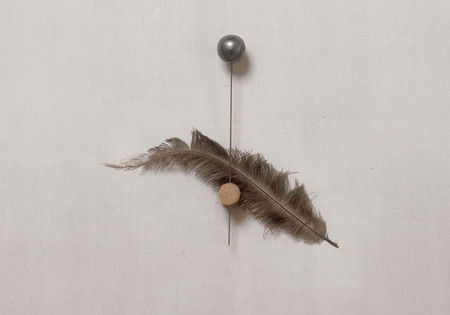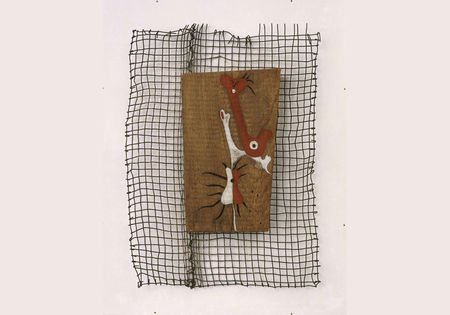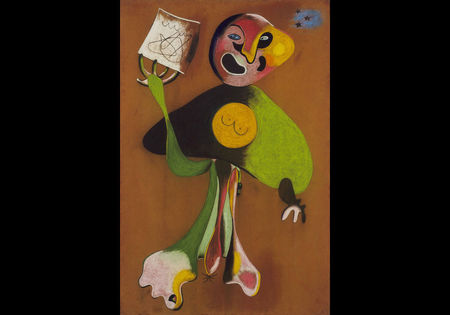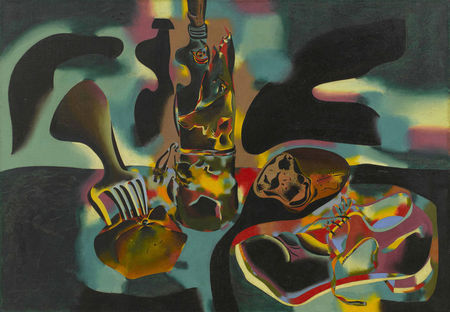"Joan Miró: Painting and Anti-Painting 1927–1937" @ The Museum of Modern Art, New York
Joan Miró. The Two Philosophers. 1936. Oil on copper, 14 x 19 5/8" (35.6 x 49.8 cm). The Art Institute of Chicago. Gift of Mary and Leigh Block. Photo: The Art Institute of Chicago. © 2008 Successió Miró / Artists Rights Society (ARS), New York / ADAGP, Paris
NEW YORK, NY.- Joan Miró: Painting and Anti-Painting 1927–1937 is the first major museum exhibition to identify the core practices and strategies Joan Miró (Spanish, 1893–1983) used to attack and reinvigorate painting between 1927 and 1937, a vital decade within his long career. Taking as its point of departure the notorious claim Miró made in 1927—“I want to assassinate painting”—the exhibition explores 12 of Miró’s sustained series from this decade, and includes some 90 paintings, collages, objects, and drawings. The exhibition is organized by Anne Umland, Curator, Department of Painting and Sculpture, The Museum of Modern Art, and will be on view in The Joan and Preston Robert Tisch Gallery, sixth floor, from November 2, 2008, through January 12, 2009.
Explains Ms. Umland, “This exhibition takes a close-up, in-depth look at a decade’s worth of Miró’s work, created during a period of economic and political turmoil, illuminating the way his drive to assassinate painting led him to reinvigorate, reinvent, and radicalize his art. The resulting body of work is at times willfully ugly, and at others savagely beautiful. It brings together both beloved masterpieces and largely unfamiliar works, transforming our understanding of Miró’s legacy for our own twenty-first century times.”
In 1941, The Museum of Modern Art organized the first full retrospective of Miró’s work to be mounted anywhere in the world, followed by major exhibitions in 1959 and 1973, and a landmark retrospective, presented on the centennial of his birth, in 1993. Fifteen years later, Joan Miró: Painting and Anti-Painting 1927–1937 offers a fresh look at the artist’s work through a tightly focused presentation of a single transformative decade.
By assembling in unprecedented depth the interrelated series of works of this decade, this exhibition repeatedly poses the question of what painting meant to Miró and what he proposed as its opposite, and in the process reveals the artist’s paradoxical nature: an artist of aggression and resistance who never ceased to be a painter, a creator of forms. Acidic color, grotesque disfigurement, purposeful stylistic heterogeneity, and the use of collage and readymade materials are among the tactics that Miró used to take apart and reconstruct painting and his own art.
The body of work Miró produced between 1927 and 1937 is symptomatic of the troubling malaise and creeping sense of doom that emerged in Europe as the so-called Roaring Twenties came to an end, and as the political tensions that would, by 1939, lead to World War II became increasingly apparent. The compressed time period examined by the exhibition reveals the extensive range of Miró’s experimentation during these years and the many different types of art making he pursued in order to produce a body of work that defiantly refuses to add up. The persistent tension he maintained between abstraction and figuration, the radical and the traditional, formal mastery and aesthetic “murder,” is among his radical achievements.
The exhibition’s principal goal is to illuminate the particular and changing character of Miró’s challenge to painting during these years, a period of his work that is generally underrecognized and not well understood. This exhibition reunites works from long-separated series, including over 20 works never before seen in the United States. The Centre Pompidou, Paris, and the Fundació Joan Miró, Barcelona, have each contributed a number of important loans to the exhibition, among them the Pompidou’s remarkable Portrait of a Dancer (1928), which has never been shown in the United States and which, for the first time since leaving Miró’s studio, will be reunited in this exhibition with the two other extant works from the artist’s series of Spanish Dancer collages.
The exhibition is organized to follow Miró’s practice of conceiving and executing his works in distinct series, adopting the artist’s own groupings and, in the case of those works that he dated by day, month, and year, reflecting the sequence of presentation that he determined. The installation is structured around 12 series created between 1927 and 1937, while working in Paris, Montroig (a rural village on the coast of Catalonia), and Barcelona. It begins with a 1927 group of works on unprimed canvas and concludes with 1937’s singular, hallucinatory painting, Still Life with Old Shoe, a work that establishes a historical endpoint for this decade-long period of experimentation. The tight chronological framework affords the opportunity to present individual series of works in sustained depth.
Series:
Joan Miró. "Un Oiseau poursuit une abeille et la baisse." 1927. Oil, aqueous medium, and feathers on glue-sized canvas, 32 7/8 x 40 1/4" (83.5 x 102.2 cm). Private collection. (c) 2008 Successió Miró /Artists Rights Society (ARS), New York / ADAGP, Paris
Paintings on Unprimed Canvas, 1927: In the first gallery of the exhibition are seven of the paintings on raw, unprimed canvas that Miró completed while working in Paris in the winter of 1927. These works mark the onset of Miró’s heightened engagement in the late 1920s with the real, tactile qualities of his materials, including paint. The prominence given to bare canvas is exceptional, both for the era and for the artist. The recurrent, often irregularly contoured passages of white gesso, a traditional ground for painting, are related to the broad areas of canvas the artist left exposed. In both cases, Miró left visible on the surface, as part of the composition, elements that would usually be covered over by pigmented oil paints, upending the conventional hierarchy of painting materials.
Joan Miró. Portrait of a Dancer. 1928. Feather, cork, and hatpin on wood panel with household paint (original feather has been replaced), 39 3/8 x 31 1/2" (100 x 80 cm). Centre Pompidou, Musée national d'art moderne-Centre de creation industrielle, Paris. Gift of Mme. Aube Breton-Elléouët. Photograph credit: CNAC/MNAM/Dis. Réunion des Musées Nationaux/Art Resource, NY. (c) 2008 Successió Miró / Artists Rights Society (ARS), New York / ADAGP, Paris
Spanish Dancers and Portrait of a Dancer, 1928: The second gallery of the exhibition features three collage-objects collectively known as the Spanish Dancers, made in Paris in 1928. Miró’s titles for these works announce their iconographic relation to the performing female body. The pronounced tactility, radical simplification, and overt erotic charge of each work is remarkable. Simple, recognizable, real-world objects and materials—corks, nails, sandpaper, a drafting triangle—double as corporeal, carnal, and erotic signs. The French Surrealist poet Paul Éluard described Portrait of a Dancer, the most austere of these works, as “the barest picture imaginable,” referring to its radical iconoclasm and to the relatively large field of white that surrounds a figure composed only of a feather, a cork, and an oversized hatpin.
Joan Miró. Dutch Interior (I). 1928. Oil on canvas, 36 1/8 x 28 3/4" (91.8 x 73 cm). The Museum of Modern Art, New York. Mrs. Simon Guggenheim Fund. Photograph credit: The Museum of Modern Art, New York, Department of Imaging Services. (c) 2008 Successió Miró /Artists Rights Society (ARS), New York / ADAGP, Paris
Dutch Interiors and Imaginary Portraits, 1928–1929: In the third gallery are six paintings—three Dutch Interiors and three Imaginary Portraits—made in Montroig in 1928 and in Paris in 1929. One of these works is based on a postcard reproduction of a seventeenth-century Dutch genre painting. Another takes the Renaissance painter Raphael’s La Fornarina (c. 1518–20) as its subject. In each case, Miró directly engaged with the tradition of Old Master painting in order to subvert it. He distorted and simplified his illusionistic models, using sharply contoured fields of flat, unmodulated, and non-naturalistic color. By eliminating atmospheric shading and introducing contradictory indicators of recessive depth, Miró explicitly rejected the driving ambition of past artists to deceive viewers into believing that the painted images they see are real.
Joan Miró. Collage (Head of Georges Auric). 1929. Tar paper and conté, crayon on paper, 43 5/16 x 29 1/2" (110 x 75 cm). Kunsthaus Zürich. Gift of Dr. Georges and Josi Guggenheim. Photograph credit: Kunsthaus Zürich. (c) 2008 Successió Miró / Artists Rights Society (ARS), New York / ADAGP, Paris
Collages, 1929: Nine of the large, chromatically austere collages that Miró made in Montroig between July and November 1929 are displayed in the fourth gallery of the exhibition. In these works the artist renounced his skills as a colorist, the rigorous control of his brushes, and his love for meticulously rendered detail. Drawn lines are kept to a relative minimum and are frequently interrupted by opaque, abstract collage elements, pitting abstraction and real material texture against the vestiges of figuration. Miró cut jagged holes in the surfaces of many of these collages, underneath which he pasted various sorts of papers. The most prevalent materials are flocked artist papers and utilitarian tar papers—the particulate matter adhered to their surfaces allowed Miró to achieve a palpable depth. Miró’s 1929 collages were shown at the Galerie Pierre, Paris, in March 1930, as the second part of a two-part exhibition. The first part of the exhibition presented his Dutch Interiors and Imaginary Portraits, suggesting that he wanted the collages and the paintings to be seen as an oppositional pair.
Joan Miró. Painting (Head). 1930. Oil on canvas, 7' 6 5/8" x 65 3/16" (230.2 x 165.5 cm). Musée de Grenoble. Photograph credit: Musée de Grenoble. (c) 2008 Successió Miró / Artists Rights Society (ARS), New York / ADAGP, Paris
Large Paintings on White Grounds, 1930: Miró predicted that the five paintings on view in this gallery, created in Paris between January and May 1930, would probably be his “goodbye to painting, at least for some time, in order to attack new means of expression, bas-relief, sculpture, etc.” The stylistic, iconographic, and even material heterogeneity of the group—he applied charcoal and, in one case, plaster to their surfaces in addition to oil paint—refuses to cohere along any purely formal or visual lines, despite the works’ comparable dimensions and dominant white grounds. Painting and Painting (The Magic of Color), installed side-by-side on the first wall as you enter the gallery, are possibly the first and second paintings in this series. Together they establish its extremes, aligning radical abstraction with deliberately disjunctive compositional strategies and willfully maladroit lines.
Joan Miró. Object. 1931.Oil, paint, and sand on wood stapled to wire mesh, 14 3/16 x 10 1/4 x 1 3/16" (36 x 26 x 3 cm). Centre Pompidou, Musée national d'art moderne-Centre de creation industrielle, Paris. Purchase. Photograph credit: CNAC/MNAM/Dis. Réunion des Musées Nationaux/Art Resource, NY. (c) 2008 Successió Miró / Artists Rights Society (ARS), New York / ADAGP, Paris
Constructions and Objects, 1930–32: Working in Montroig between August and November 1930, Miró created as many as 12 relief constructions, although only the two on view in this gallery are known to have survived. The following year he began to make small objects, including the six presented in this gallery, that frequently combine found materials with painted figures and passages of glued sand, juxtaposing real-world objects with imaginative images to create a richly volatile mix of painting and assemblage. Miró and the Surrealists pointedly referred to many of the three-dimensional works he made between 1931 and 1932 as objects, not sculptures, to underscore their distance from aesthetic conventions and norms. Wood panels and blocks recur frequently, both as defiant references to the tradition of painting on wood and as surfaces onto which objects are nailed or stapled.
Joan Miró. Drawing-Collage. 1933. Conté crayon, postcards, sandpaper, and printed paper on flocked paper, 42 ½ x 28 3/8" (108 x 72.1 cm). The Museum of Modern Art, New York. Kay Sage Tanguy Bequest. (c) 2008 Successió Miró / Artists Rights Society (ARS), New York / ADAGP, Paris
Paintings Based on Collages, 1933: Miró created the six pairs of collages and paintings presented in this gallery in 1933, working in a small studio in his mother’s apartment in Barcelona. The collages were created as a group between January 26 and February 11, followed by the paintings, which Miró worked on from March 3 to June 13. He dated each collage and painting by day, month, and year, a practice that permits a precise historical reconstruction of their evolution. Each of the collages features an array of mechanically reproduced illustrations cut from catalogues, magazines, and newspaper advertisement. Performing an odd inversion of working from life, through these pairs of collages and paintings Miró made visible his radical transformation of small, pictorial collage elements into abstract, biomorphic forms, which appear to float in suspension against softly atmospheric backgrounds.
Joan Miró. Painting. 1933.Oil and aqueous medium on canvas, 51 3/8 x 64 1/4" (130.5 x 163.2 cm). Philadelphia Museum of Art. A.E. Gallatin. Collection. Photograph credit: Graydon Wood. (c) 2008 Successió Miró /Artists Rights Society (ARS), New York / ADAGP, Paris
Drawing Collages, 1933–1934: Miró experimented extensively with collage between August 1933 and June 1934 in Montroig and Barcelona. The six works presented in this gallery are studies in contrasts. Miró retrospectively described them as “drawing-collages,” calling attention to the interplay between the artist’s hand, raw materials, and mechanical reproduction that animates each to different effects. Three of these collages prominently feature postcards, positioned on large sheets of colored flocked paper along with chromolithographic illustrations and cut-outs of engravings. In these works Miró juxtaposed sinuous, rhythmic drawn conté-crayon lines with found collage elements, and the flocked paper’s texture with the smooth surfaces of the postcards and other printed matter. Beginning in 1934, Miró adopted a wider variety of materials and paper types. In two collages completed on the same day, displayed here side-by-side, Miró used reflective aluminum paper as his surface, which introduces shifting reflections and blurred movement into the composition.
Joan Miró. Woman (The Opera Singer). 1934. Pastel and pencil on flocked paper, 42 x 28" (106.7 x 71.1 cm). The Museum of Modern Art, New York. Gift of William H. Weintraub. Photograph credit: The Museum of Modern Art, New York, Department of Imaging Services. (c) 2008 Successió Miró / Artists Rights Society (ARS), New York / ADAGP, Paris
Pastels on Flocked Paper, 1934: In 1934 Miró’s work underwent a profound transformation that included a partial return to illusionism and the pursuit of what he called “aggressiveness” through color. The date inscribed on the back of each of these works, October 1934, makes a direct connection to a particular historical moment, although Miró’s correspondence shows that he continued to work on them well into November. October was a traumatic month for Spain that year. General labor strikes erupted throughout the country, a state of war was declared, and the army was authorized to violently suppress the rebellion. Although Miró was in Montroig when the hostilities broke out in Barcelona and elsewhere, his letters make clear that he perceived a real danger. The engorged, luridly colored, and illusionistically modeled anatomies of what he later described as his “savage” pastels signal a rupture with the past that is proportional to the highly charged political situation.
Joan Miró. Rope and People, I. 1935. Oil on cardboard mounted on wood, with coil of rope, 41 1/4 x 29 3/8" (104.8 x 74.6 cm). The Museum of Modern Art, New York. Gift of the Pierre Matisse Gallery. Photograph credit: The Museum of Modern Art, New York, Department of Imaging Services. (c) 2008 Successió Miró / Artists Rights Society (ARS), New York / ADAGP, Paris
Paintings on Cardboard and Object (Object of Sunset), 1935–1936: Between January and May 1935, Miró completed a series of paintings on identical sheets of cardboard. He considered this series of paintings, six of which are on view here, to constitute what he described as an autorévision of his career: a self-orchestrated retrospective or critical self-review. The series is notable for its diversity of style, iconography, and materials. Head of a Man (1935) uses lurid colors and heavy shading to portray a distorted, empty-eyed head with an obscenely protruding tongue. Rope and People I (1935) features a crude hank of coiled rope secured in the middle of the painting. Object (Object of Sunset) (1935), also on view in this gallery, falls outside the series of paintings on cardboard but it, too, participates in the artist’s project of self-review. Although clearly connected to the objects Miró made in 1931 and 1932, it stands apart due to the extraordinary character of its primary physical component: the stump of a carob tree, which creases at the bend like human flesh, covered with glossy red paint and a schematic sign for the female sex.
Small Paintings on Masonite and Copper, 1935–1936: Eleven small paintings on alternating panels of copper and Masonite—a board made of wood chips, for building and other commercial uses—that Miró created between October 1935 and May 1936 are presented in this gallery. In letters to his dealer, Pierre Matisse, concerning this series, Miró emphasized the meticulous nature of his technique and the solidity of the supports on which he was working; these supports offered, in his words, “maximum resistance.” The exquisitely precise execution of these diminutive paintings belies their thematic brutality. Color throughout the series is high-keyed, intense, and acidic. Modeling is employed summarily, lending a quasi-physical presence to the silly yet horrifying, grotesquely deformed figures that populate these jewel-like landscapes.
Paintings on Masonite, 1936: Between mid-July and mid-October 1936, Miró worked steadily on a series of mixed-medium paintings of uniform size executed on Masonite panels, seven of which are presented in this gallery. He began these works just days before the outbreak of the Spanish Civil War on July 17 and 18, and it has long been suggested that these works represent Miró’s response to the emotional and physical turmoil in his homeland, although the artist insisted that they were produced “despite the current events.” In these works, narrative is replaced by a heightened emphasis on texture and materials, including oil and enamel paints, casein, tar, sand, and pebbles. Miró sometimes violently attacked his Masonite panels, gouging craters into their fibrous matrix, creating irreversible marks and conveying a sense of raw immediacy.
Joan Miró. Still Life with Old Shoe. 1937. Oil on canvas, 32 x 46” (81.3 x 116.8 cm). The Museum of Modern Art, New York. Gift of James Thrall Soby. Photograph credit: The Museum of Modern Art, New York, Department of Imaging Services. © 2008 Successió Miró / Artists Rights Society (ARS), New York / ADAGP, Paris
Still Life with Old Shoe, 1937: Miró left Barcelona for Paris sometime before October 28, 1936. With the civil war in Spain advancing without a foreseeable end, he decided to remain in the French capital; his wife and daughter joined him in December. They would not return to Spain for four years. On January 12, 1937, Miró announced his intent to do “something absolutely different,” and abruptly returned to working from life—from the observation of an external model, of real objects arranged in space. The result was the incandescent, hallucinatory painting Still Life with Old Shoe, which marks a historical endpoint to the decade-long period presented in this exhibition. The painting is both a still life and a landscape, in which the irregular back edge of the tabletop can also be read as an undulating horizon line. Scale and perspective have been adjusted, so that the worn old shoe dwarfs the surrounding objects. The color is highly saturated and dissonant, and the objects seem to glow from within.
Joan Miró. Woman. 1934. Pastel on flocked paper, 42 x 28" (106.7 x 71.1 cm). The Metropolitan Museum of Art, New York. Bequest of Richard S. Zeisler. Photograph credit: The Metropolitan Museum of Art, New York. (c) 2008 Successió Miró / Artists Rights Society (ARS), New York/ ADAGP, Paris

/https%3A%2F%2Fprofilepics.canalblog.com%2Fprofilepics%2F1%2F0%2F100183.jpg)
/https%3A%2F%2Fstorage.canalblog.com%2F03%2F02%2F119589%2F96711876_o.jpg)
/https%3A%2F%2Fstorage.canalblog.com%2F11%2F31%2F119589%2F94773502_o.jpg)
/https%3A%2F%2Fstorage.canalblog.com%2F20%2F83%2F119589%2F94772815_o.jpg)
/https%3A%2F%2Fstorage.canalblog.com%2F26%2F72%2F119589%2F75604929_o.jpg)
/https%3A%2F%2Fstorage.canalblog.com%2F59%2F60%2F119589%2F26458628_o.jpg)















/http%3A%2F%2Fstorage.canalblog.com%2F96%2F53%2F119589%2F120584922_o.jpg)
/http%3A%2F%2Fstorage.canalblog.com%2F03%2F29%2F119589%2F113216902_o.jpg)
/http%3A%2F%2Fstorage.canalblog.com%2F24%2F21%2F119589%2F112417103_o.jpg)
/http%3A%2F%2Fstorage.canalblog.com%2F00%2F76%2F119589%2F112191058_o.jpg)